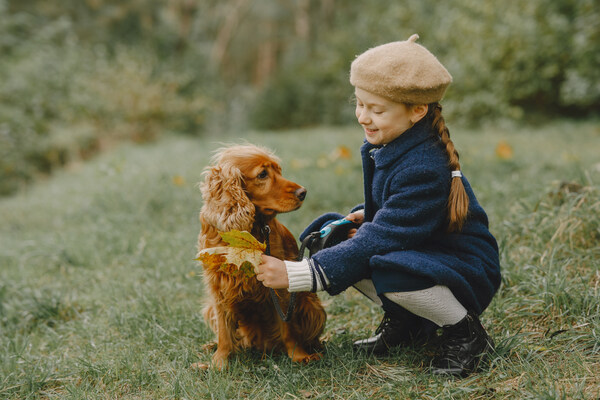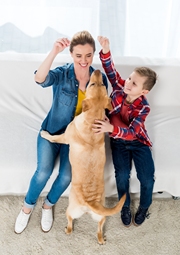Teaching Kids Responsibility through Dog Ownership
Considering both the ownership of a dog and the qualities of a dog to teach kids responsibility is a good thing and an invaluable lesson in life. Teaching them how to then become responsible caregivers of a pet will enhance the experience for kids and enable them to be more compassionate towards animals.
Through the daily tasks of feeding, walking, and grooming their dog, children learn to be accountable and considerate of others’ needs in general. This experience not only instills a sense of responsibility but also nurtures empathy and kindness towards animals.
Here are some misconceptions and helpful advice for parents thinking about using dog possession as a means to help children become more responsible.
Assign Age-Appropriate Tasks
When involving children in the care of a pet, it’s important to assign age-appropriate tasks to ensure both the safety of the pet and the effectiveness of the lesson in responsibility. Here are some unique tips for age-appropriate tasks:
Toddlers (Ages 2-3)
- Supervised Petting: Teach gentle petting and respect for the pet’s space.
- Simple Commands: Encourage toddlers to use simple commands like “sit” or “stay” while you assist.
- Fetch Helper: Allow them to throw a toy for the dog to fetch, promoting playtime interaction.
Preschoolers (Ages 4-5)
- Filling Water Bowls: Let them fill the water bowl under supervision.
- Brushing Fur: Give them a soft brush to gently groom the pet.
- Toy Collection: Encourage them to pick up and put away pet toys.
Early Elementary (Ages 6-7)
- Feeding: Allow them to measure and pour the pet’s food.
- Walking Assistance: Accompany them on short walks while they hold the leash with you.
- Clean-Up Helper: Involve them in simple clean-up tasks like wiping food bowls or picking up toys.
Middle Elementary (Ages 8-10)
- Solo Walking: Allow them to take the pet on short, supervised walks.
- Basic Training: Teach them to give commands and reward the pet with treats.
- Clean-Up Duty: Assign them the task of cleaning the pet’s living area, like cages or beds.
Preteens (Ages 11-12)
- Independent Feeding: Trust them to feed the pet without supervision.
- Grooming: Teach them more advanced grooming tasks such as bathing.
- Vet Visits: Involve them in preparing for and attending veterinary visits.
Teens (Ages 13+)
- Exercise Responsibility: Allow them to take the pet for regular, unsupervised walks or runs.
- Health Monitoring: Teach them to recognize signs of illness and the importance of regular vet check-ups.
- Training and Socialization: Encourage them to take part in training classes or socialization activities with other pets.
The children should be closely monitored by their parents in the initial stages of caring for your dog. This creates a chance for correction to the appropriate methods for the particular dog breeds and to check whether their pet’s needs have been met properly.
Empowering Kids to Stick With It
Once you have ensured your children are property equipped to handle the daily needs for proper care of a pet, structure and encouragement is important to maintain their commitment. This will motivate and prevent them from feeling overwhelmed.
Create a Routine
Setting some form of daily schedule for dog care enables the children to appreciate that being a pet owner means having to care for and attend to your pet at regular intervals. This means that feeding times, walking schedules, and scheduled playtime may have to be included in the child’s day to help them understand the need for a schedule.
Encourage Empathy
It is also a good opportunity to work on the child’s empathy and ability to understand others and their feelings and needs utilizing the connection between the child and the dog. Help children work through their thoughts and focus on the dog’s thoughts, moods, and feelings, thereby promoting empathy.

Image by prostooleh on Freepik
Reward Responsibility
Commend children when they take care of the dog as expected and check that they do not leave any task undone. Praise can encourage them to keep on being good guardians, thus increasing their willingness to work harder.
Involve Kids in Decision-Making
Engage the children in things as basic as a selection of toys, types of foods to feed the dog, or even when choosing the ways to train the dog. It also helps in developing the feeling of responsibility for the pet, thus, the ability to pay huge amounts towards the a dog’s health and welfare.
Educate on Safety
Ensure children learn one or more techniques on dog safety such as the appropriate way of reaching out, touching, or playing with the pet. Because of this, not only is the life of the child safeguarded, but also, the pragmatic interaction between the child being taught as well as the dog is most harmonious.
Use Mistakes as Learning Opportunities
The achievement of effective educational outcomes depends on taking mistakes, not only as a signal of an error being made, but also as a driving force for students to learn from their own mistakes. Children are bound to make mistakes whenever they are servicing a pet animal as they will still be learning how to do it right. As stated before, do not look at such instances as reasons to reprimand but instead make them to be learning experiences. Help them correct wrong deeds and ask them to improve in the correct way the next time around.
Conclusion: Life Enhancing Lessons
Teaching kids’ responsibility through dog ownership is a wonderful way to instill important values and skills in children. In this way, their involvement as pet caregivers can help parents instill empathy, responsibility, and self-control in their children.
Tasks that require children to take care of another living being should include activities that are always age-related. Don’t take anything for granted when it comes to a child’s knowledge of what a dog needs. Children should understand why their responsibilities need to be done on properly and on schedule. Setting specific expectations ensures they are not discouraged in their commitment to help care for the family dog.
Teaching children to understand safety issues when caring for another living being is a lifelong lesson that extends into all areas of life. Explaining to kids the “why” of pet care is as important as the “how” to provide care for your dog. None of this happens without continual positive reinforcement and instruction from parents. Ultimately, it affects the formation of a child’s character and how they will understand and relate to others at school and in society in general.




